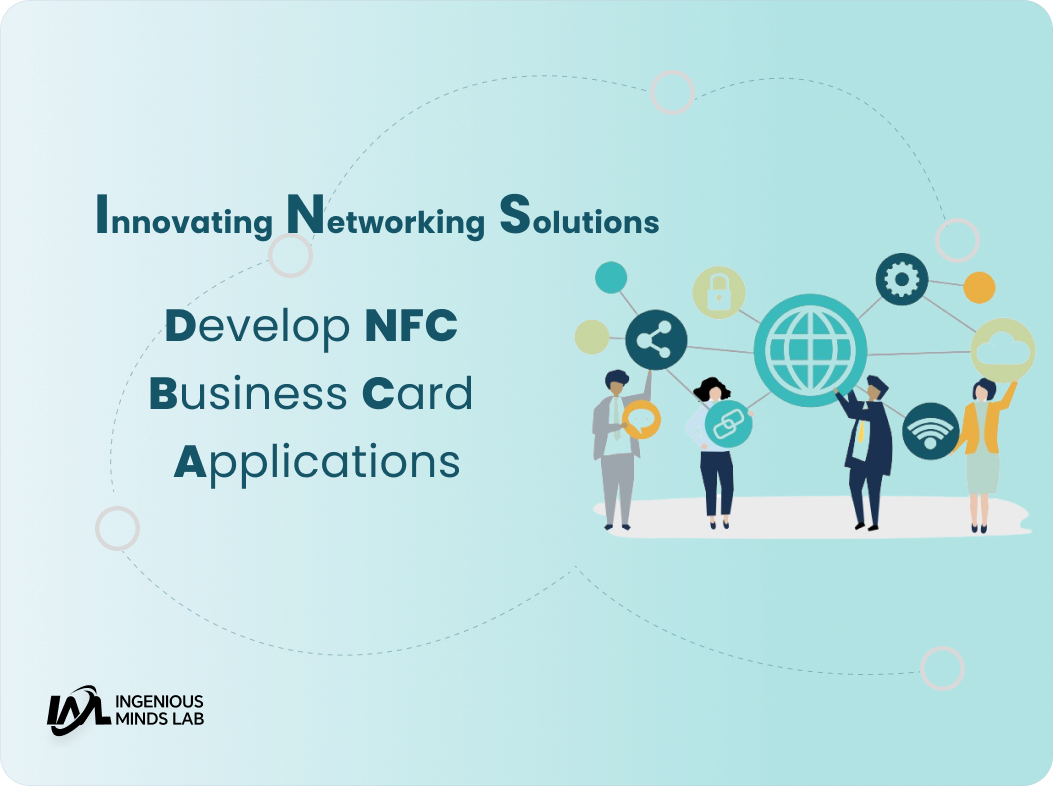In today’s digitally-driven world, networking has become more essential than ever. Traditional methods of exchanging contact information, such as paper business cards, are quickly becoming outdated. Enter the era of NFC (Near Field Communication) technology, where the exchange of contact details is as simple as a tap. At the forefront of this revolution are custom NFC business card applications. These applications empower businesses to develop personalized digital business cards that can be effortlessly shared and accessed via NFC-enabled devices Lets Discuss how to Develop NFC Business Card Applications.
The development of NFC business card applications marks a significant step forward in networking solutions. By harnessing the power of NFC technology, businesses can create dynamic and interactive digital business cards that leave a lasting impression on clients, partners, and prospects. With the ability to integrate various data fields, customize design elements, and track engagement metrics, these applications offer unparalleled versatility and effectiveness in networking.
Key features of developing NFC business card applications include secure user authentication, intuitive user interfaces for card creation and management, comprehensive analytics dashboards, and seamless integration of affiliate programs for expanded reach and engagement. Additionally, these applications prioritize user experience, ensuring that sharing and accessing digital business cards is as seamless and intuitive as possible.
Develop NFC Business Card Applications: Dynamic NFC Business Card Creation and Management
if you are looking for Develop NFC Business Card Applications One of the essential features we will implement in our NFC business card application is the ability for users to dynamically create and manage their digital business cards. This feature will empower users to tailor their cards to their unique needs, ensuring they make a lasting impression on potential contacts. Below are the key components of this feature:
Dynamic Card Creation:
- Users will have the ability to create digital business cards with customizable fields, including but not limited to name, title, company, phone number, email address, website, social media links, and a brief bio.
- Customizable design options will be available, allowing users to choose from various templates, colors, fonts, and layout options to reflect their brand identity.
- Integration with NFC technology will enable users to embed their contact information into NFC-enabled cards for seamless sharing and access.
Intuitive Management Interface:
- A user-friendly interface will facilitate easy management of digital business cards, allowing users to edit, update, or delete card details as needed.
- Users will have the flexibility to activate or deactivate specific cards, depending on their networking needs.
- Options for bulk actions, such as duplicating cards or importing/exporting contacts, will streamline the card management process.
Cloud-Based Storage and Synchronization:
- All created digital business cards will be securely stored in the cloud, ensuring accessibility from any NFC-enabled device with internet connectivity.
- Synchronization capabilities will ensure that any changes made to digital business cards are reflected across all linked devices in real-time, providing users with a seamless and consistent experience.
Analytics and Insights:
- Robust analytics tools will provide users with valuable insights into the performance of their digital business cards, including metrics such as scan activity, engagement rates, and conversion rates.
- Users will be able to track the effectiveness of their networking efforts and make data-driven decisions to optimize their interactions and connections.
By implementing the Dynamic NFC Business Card Creation and Management feature, we aim to empower users with the tools they need to create impactful digital representations of their professional identity, foster meaningful connections, and drive business growth.
Detailed Front-end Requirements For Develop NFC Business Card Applications
- User Authentication and Registration:
- Develop a secure login page allowing users to create new accounts or log in using existing credentials.
- Implement authentication mechanisms such as email verification or two-factor authentication for enhanced security.
- Design an intuitive registration process, prompting users to provide necessary information such as name, email address, and password.
- User Profile Management:
- Create a user profile dashboard where users can view and edit their personal information, including name, contact details, and profile picture.
- Provide options for users to manage their privacy settings and notification preferences.
- Dynamic Card Creation Interface:
- Design an intuitive interface for users to create and customize their digital business cards.
- Include customizable fields such as name, title, company, phone number, email address, website, and social media links.
- Provide options for users to select from various templates, colors, fonts, and layout options to personalize their cards.
- Theme Selection and Customization:
- Implement a feature allowing users to choose from a selection of themes for their digital business cards.
- Provide customization options for users to adjust colors, fonts, and other design elements to align with their brand identity.
- Directory and Contacts Management:
- Develop a directory where users can view and manage their contacts and saved business cards.
- Enable users to organize contacts into categories or groups for easy access and management.
- Implement features for users to search, filter, and sort contacts based on specific criteria.
- Integration with NFC Technology:
- Ensure seamless integration with NFC technology to enable users to share and access digital business cards via NFC-enabled devices.
- Develop functionalities for users to tap their devices together to exchange contact information quickly and efficiently.
- Analytics and Insights Dashboard:
- Create an analytics dashboard where users can track the performance of their digital business cards.
- Provide insights into metrics such as scan activity, engagement rates, and conversion rates to help users assess the effectiveness of their networking efforts.
- Responsive Design and Cross-Platform Compatibility:
- Design the front-end interface to be responsive, ensuring optimal display and functionality across various devices and screen sizes.
- Ensure cross-platform compatibility to support access from desktops, laptops, tablets, and smartphones.
- Live Preview: Provide users with a live preview of their digital business card as they make changes to the design and content. This allows users to see how their card will appear in real-time before finalizing it.
- Interactive Design Elements: Incorporate interactive design elements such as animations or hover effects to make the user interface more engaging and visually appealing.
- Social Media Integration: Enable users to link their social media profiles directly to their digital business cards, allowing recipients to easily connect with them on various social platforms.
- QR Code Generation: Offer users the option to generate a QR code for their digital business card, in addition to NFC capabilities. This provides an alternative method for sharing contact information with individuals who may not have NFC-enabled devices.
- Multi-Language Support: Implement multi-language support to cater to users from diverse linguistic backgrounds. Allow users to select their preferred language for the interface and content.
- Collaborative Editing: Enable users to collaborate on the creation and editing of digital business cards, allowing multiple team members or collaborators to contribute to the design and content.
- Integration with Third-Party Services: Integrate with third-party services such as email marketing platforms or CRM systems to streamline lead generation and customer relationship management processes.
- Tutorial and Help Section: Provide users with access to tutorials, guides, and FAQs to help them navigate the application and make the most out of its features. Include tooltips or contextual help within the interface for on-the-spot assistance.
- Feedback Mechanism: Implement a feedback mechanism that allows users to provide suggestions, report issues, or request new features directly within the application. Use this feedback to continuously improve the user experience and iterate on the application’s features.
- Accessibility Features: Ensure that the application complies with accessibility standards and guidelines, making it accessible to users with disabilities. Incorporate features such as screen reader compatibility, keyboard navigation, and high contrast modes.
If you Develop NFC Business Card Applications then By fulfilling these detailed front-end requirements, we aim to deliver a user-friendly and visually appealing interface that enhances the user experience and facilitates seamless interaction with the NFC business card application.
Which Technology you should choose For Develop NFC Business Card Applications
if you are looking for Develop NFC Business Card Applications then Integrating Flutter for the front-end and Laravel or Node.js for the backend can provide a robust and scalable solution for the NFC business card application. Here’s how you can leverage each technology:
Front-end with Flutter: Flutter is a cross-platform UI toolkit developed by Google, known for its ability to create beautiful and highly performant user interfaces. Utilizing Flutter for the front-end of the NFC business card application offers several advantages:
- Cross-Platform Development: Flutter allows you to write code once and deploy it across multiple platforms, including iOS, Android, web, and desktop, reducing development time and effort.
- Hot Reload: Flutter’s hot reload feature enables developers to see changes instantly, speeding up the development process and facilitating iterative design improvements.
- Rich UI Components: Flutter provides a rich set of customizable UI components and widgets, allowing you to create visually stunning and interactive user interfaces for the application.
- Native Performance: Flutter compiles to native code, providing excellent performance and ensuring a smooth user experience across different devices and platforms.
Backend with Laravel or Node.js: For the backend of the NFC business card application, you can choose either Laravel (PHP framework) or Node.js (JavaScript runtime). Both options offer robust features and support for building scalable and efficient server-side applications:
- Laravel (PHP):
- Laravel is a popular PHP framework known for its elegant syntax, expressive features, and developer-friendly environment.
- Features such as Eloquent ORM, Blade templating engine, and Laravel Mix for asset compilation make development faster and more enjoyable.
- Laravel also offers built-in support for authentication, routing, caching, and database migrations, simplifying backend development tasks.
- Node.js:
- Node.js is a JavaScript runtime built on Chrome’s V8 JavaScript engine, enabling server-side JavaScript execution.
- With its non-blocking I/O model and event-driven architecture, Node.js is well-suited for building real-time, scalable, and high-performance applications.
- Node.js ecosystem includes a vast selection of libraries (such as Express.js for web framework, Sequelize for ORM, and Passport.js for authentication) that streamline backend development tasks.
Integration: To integrate Flutter with Laravel or Node.js backend, you can use RESTful APIs or GraphQL for communication between the front-end and backend components. These technologies enable seamless data exchange and interaction between the client-side and server-side components of the application.
In conclusion, Develop NFC Business Card Applications with Flutter and Laravel/Node.js opens up endless possibilities for modern networking solutions. By harnessing the power of NFC technology and leveraging the capabilities of these cutting-edge technologies, businesses can streamline contact sharing, enhance user engagement, and unlock new networking opportunities. Whether you’re a developer, entrepreneur, or business professional, embracing this innovative approach to networking can propel your success in today’s interconnected world. Join us on this journey as we explore the limitless potential of NFC business card applications and revolutionize the way we connect and network.

